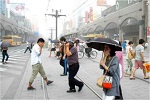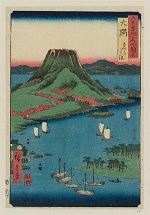Eruption of Sakurajima
Tara Giangrande, Swarthmore College, Class of 2016
This hand-tinted lantern slide from the E. Raymond Wilson Collection captures the incredible force of the volcanic eruption of Sakurajima, located in the Kagoshima prefecture of Kyushu, in January of 1914. This was the largest eruption in Japan in the twentieth century. An enormous lava flow that destroyed surrounding homes and villages was accompanied by a massive earthquake and further devastation. Fortunately, earthquakes leading up to the eruption signaled its coming, and local people had time to evacuate the island and much of the surrounding area before the eruption took place. Still, it is estimated that up to 140 people died as a result of the eruption itself and corresponding earthquakes, landslides, and building collapses (Siebert, Simkin, & Kimberly, 2011, p. 338). The lava flow was so large that it connected Sakurajima, previously an island, to the nearby coast, which suffered extensively from earthquake damage ("Kagoshima," 2013).
The view of the island provided by the lantern slide appears to be taken from this coast. It does not appear that any of the buildings in the foreground have suffered structural damage. Additionally, the somewhat intact shape of the billowing cloud of volcanic ash indicates that this image was probably captured toward the beginning of the eruption. However, we can see the debris falling out as the wind blows it toward the left side of the picture frame. It is truly an incredible moment which, from this safe distance, can almost be admired for its immense natural majesty.
The origins of this lantern slide and its somewhat idyllic depiction of such a terrifying event are also notable in that the slide is dated between 1926 and 1927, over a decade after the eruption of Sakurajima took place. This shows that images of the eruption were being produced long after its occurrence. While this may seem a bit odd, it reveals much about how natural disaster impacts and even drives Japanese tourism. Lantern slides were produced at this time on a large scale to serve as tokens or souvenirs for visitors (mostly Westerners) to Japanese landmarks (Yoder, 2006). We can thus interpret this image as portraying the 1914 eruption in a way that was attractive and interesting to tourists visiting Sakurajima years later. It makes sense that such an image would be absent of any real indications of the suffering and destruction caused by the eruption.
Sakurajima is one of the world's most active volcanoes, erupting over 500 times in the past year alone (Oskin, 2013). While the 1914 eruption has yet to be equaled in its fervor since its occurrence, the memory of the tragic event looms over people currently living in the shadow of Sakurajima. As the hundredth anniversary of this eruption approaches, the volcano becomes increasingly volatile.
A news report photo from August 18, 2013 captures local citizens going about their daily lives despite a recent spewing of volcanic ash from Sakurajima. It seems as though, for these people, a volcanic eruption is just another change in the weather, as they raise their umbrellas, cover their mouths, and walk on through clouded streets. We can imagine how living with the continual prospect of disaster affects daily consciousness in Japan.
Sakurajima has been a frequent subject of Japanese visual culture for centuries. A woodblock print by the renowned nineteenth-century woodblock artist Utagawa Hiroshige from his series "Famous Places in the Sixty-odd Provinces" illustrates the traditional iconography associated with the island. Entitled "Ōsumi Province: Sakura-jima," the print shows Kagoshima bay with numerous boats from which Sakurajima majestically arises. The most notable aspect of the print is the abundance of cherry blossoms that appear in the valleys and ridges of the island. This inclusion is not surprising when considering that the name of the island can be broken down into sakura, meaning "cherry," and jima, meaning "island" (Stewart, 1979, p. 162). Yet while the name "Cherry Island" suggests an abundance of cherry blossoms, the reality of Sakurajima's environment contradicts this association. Today, if you were to visit Sakurajima, you would be hard-pressed to find a single cherry tree on the entire island. While this may seem nonsensical, we must take into account the fact that in the Japanese landscape tradition, reality often takes a backseat to collective associations of place with culturally and artistically significant imagery. The depiction of cherry blossoms in this print demonstrates Hiroshige's use of artistic license in representing Sakurajima according to its name rather than its actual environment.
In both the lantern slide and Hiroshige's print, we can detect a tailoring of the composition toward a glossing over or alteration of the reality of Sakurajima. In the lantern slide, a broad landscape perspective does not engage the devastation that the depicted eruption caused. Hiroshige's print serves a similar purpose of distributing a view of the island on a broad scale to people who have no way of knowing whether the illustration he provides is accurate. In both cases, the way in which Sakurajima is depicted has been carefully considered and tailored so as to engage the interest of the viewer in a specific manner. Thus, these two very different images provide an enlightening juxtaposition of methods of engaging audience interest in Japanese landscape.


